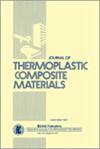Improving the material extrusion processing of thermoplastic olefin/graphene nanoplatelet composites through control of the morphology
IF 3.4
4区 材料科学
Q2 MATERIALS SCIENCE, COMPOSITES
引用次数: 0
Abstract
The aim of this research is to develop thermoplastic olefin (TPO) composites containing polypropylene (PP), an elastomeric ethylene-octene copolymer (EOC) and graphene nanoplatelets (GNPs), suitable for material extrusion (MEX). A PP functionalized with amino-pyridine (PP-g-Py) was used as a compatibilizer. The composite blends had droplet-matrix morphology at compositions as high as 40 wt% EOC. Imaging by Transmission Electron Microscopy showed that the GNPs resided at the interface between the blend components. This microstructure promoted higher thermal conductivity of the TPO/GNP composite blends, as compared to the PP/GNP composite (1.54 W/m K, vs 1.3 W/m K respectively). PP/GNP composites processed by MEX exhibited inadequate interfacial fusion between the deposited strands, which resulted in severe delamination during tensile and flexural testing, and consequently poor mechanical properties. In the TPO/GNP composites containing 40 wt% EOC, the slower crystallization of the elongated EOC domains promoted interfacial adhesion between the strands, resulting in better part consolidation, more consistent mechanical properties and improved ductility compared to the PP/GNP composites.通过控制形态改进热塑性烯烃/石墨烯纳米微晶复合材料的挤压加工工艺
本研究旨在开发适用于材料挤压(MEX)的含有聚丙烯(PP)、弹性乙烯-辛烯共聚物(EOC)和石墨烯纳米颗粒(GNPs)的热塑性烯烃(TPO)复合材料。氨基吡啶功能化聚丙烯(PP-g-Py)被用作相容剂。在 EOC 含量高达 40 wt% 时,复合混合物具有液滴-基质形态。透射电子显微镜成像显示,GNPs 存在于混合物组分之间的界面。与 PP/GNP 复合材料相比,这种微观结构提高了 TPO/GNP 复合材料混合物的热导率(分别为 1.54 W/m K 和 1.3 W/m K)。用 MEX 处理的 PP/GNP 复合材料显示出沉积股之间的界面融合不充分,导致在拉伸和弯曲测试中出现严重的分层,因而机械性能较差。与 PP/GNP 复合材料相比,在含有 40 wt% EOC 的 TPO/GNP 复合材料中,拉长的 EOC 结构域的结晶速度较慢,从而促进了股间的界面粘合,使部件固结性更好,机械性能更稳定,延展性更好。
本文章由计算机程序翻译,如有差异,请以英文原文为准。
求助全文
约1分钟内获得全文
求助全文
来源期刊

Journal of Thermoplastic Composite Materials
工程技术-材料科学:复合
CiteScore
8.00
自引率
18.20%
发文量
104
审稿时长
5.9 months
期刊介绍:
The Journal of Thermoplastic Composite Materials is a fully peer-reviewed international journal that publishes original research and review articles on polymers, nanocomposites, and particulate-, discontinuous-, and continuous-fiber-reinforced materials in the areas of processing, materials science, mechanics, durability, design, non destructive evaluation and manufacturing science. This journal is a member of the Committee on Publication Ethics (COPE).
 求助内容:
求助内容: 应助结果提醒方式:
应助结果提醒方式:


